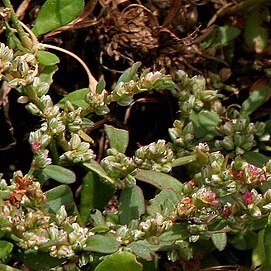Herbs annual. Stems prostrate, 10-40 cm tall, much branched from base, usually internodes shorter than leaves. Petiole very short or nearly absent; leaf blade narrowly elliptic or oblanceolate, 5-15 × 2-4 mm, both surfaces with conspicuous midvein and inconspicuous lateral veins, base narrowly cuneate, margin entire, apex obtuse or acute; ocrea white, 2.5-3 mm, membranous, apex lacerate. Flowers 3-6, in axillary fascicles; bracts membranous. Pedicels shorter than bracts, articulate at middle. Perianth green, margin white or pinkish, 5-parted; tepals narrowly elliptic, 1-1.5 mm, abaxially with prominent veins. Stamens 5; filaments included, slightly dilated at base. Styles 3, rarely 2, very short; stigmas capitate. Achenes included in persistent perianth, black-brown, shiny, broadly ovoid, trigonous or biconvex, 1.5-2 mm, smooth. Fl. May-Aug, fr. Jun-Sep. 2n = 20.
A glabrous, much branched, prostrate, leafy, annual herb.. Stems scabrid, reddish-brown.. Ocreae silvery in the upper part or throughout most of their length, with concolorous veins, very readily lacerating, fringed with laciniae of varying length up to 2 mm. long.. Leaves very small, up to 13 × 2.5 mm., all of a similar size, linear to narrowly obovate-elliptic, marginally revolute, glabrous and rather leathery, dark green becoming red; midrib obvious but lateral veins scarcely perceptible.. Inflorescence a shortly branched, leafy, congested raceme.. Flowers in axillary clusters 1–3 (–5) together.. Perianth greenish, 2 mm. long. Tepals 4, ± 1.5 mm. long, lanceolate-elliptic, the outer pair keeled, the inner pair flat.. Styles 3, free, ± 3 mm. long.. Nut trigonous, smooth, black, shining, 1.5–2 mm. long.. Fig. 3/6 and 7.
Prostrate, nearly glabrous, mat-forming herb; taproot present; stems usually < 15 cm long, with angles minutely puberulent. Lvs all similar, sessile. Lamina 3-9 × 0.5-1.5 mm, linear or slightly spathulate, granular-punctate, entire; lateral veins not evident but midrib conspicuous; base attenuate; apex obtuse or subacute. Ochreae to c. 3 mm long, silvery-hyaline, soon lacerate with aristate points, often enclosing nearly 1/2 the internode. Fls axillary, in fascicles of 1-5; pedicels to c. 0.5 mm long at anthesis, usually enclosed by ochreae. Perianth c. 1 mm long at anthesis, pinkish, accrescent; segments imbricate, oblong. Nut 1.2-1.7 mm long, ovoid, dark brown or black, smooth, glossy, triquetrous with ridges obtusely angled.
Prostrate, closely leaved, annual herb, 0.05-0.45 m high; taproot well developed; stems much branched from base, longitudinally grooved, internodes on main stems < 12 mm long. Ocreae silvery, hyaline, fringed with laciniae. Leaves small, linear-oblong to narrowly elliptic, up to 25 x 5 mm, apex rounded, narrowing at base, margins revolute, surfaces punctate glandular. Bracts silvery hyaline. Flowers fascicled in axils of leaves, 1-5 flowers per bract. Perianth pink, white or greenish. Stamens 6-8, included. Flowering time Oct.-May. Fruit a black, shiny, smooth nut.
Annual herb; mat-forming; leafy. Stems procumbent, up to 1 m long. Leaves subsessile; blade oblong or linear-oblong to elliptic, 5-13 x 2-5 mm, all similar in size. Ocrea silvery hyaline, ± 5 mm long, deeply lacerate, veins inconspicuous. Flowers: in many, axillary fascicles; perianth lobes greenish with creamy-white or pinkish margins; Oct.-May. Fruit shiny dark brown or black.
Leaves all similar, subsessile; lamina rather leathery and glabrous, dark green to reddish-brown, 5–13 × 2–5 mm, oblong or linear-oblong to elliptic, acute and slightly mucronate at the apex, attenuate to the base, margins revolute, midrib conspicuous.
A small herb. It lays along the ground. It grows 15 cm high. The leaves are narrow. They do not have leaf stalks. There are leaf like structures at the base of the leaf stalk. The flowers are in the axils of leaves. They are pink.
Perianth 2 mm long, deeply lobed; lobes greenish with creamy-white or pinkish-white to reddish-pink margins, 1.5 mm long, lanceolate-elliptic.
Prostrate herb. Internodes of main stem usually shorter than 12 mm. Leaves narrower than 3 mm. Nut trigonous, shiny. Flowers white or pink.
Flowers subsessile, in numerous 1–3(5)-flowered axillary fascicles; fascicles surrounded by leafy bracts.
Ocrea silvery hyaline at least above, c. 5 mm long, deeply lacerate, with inconspicuous veins, glabrous.
Stems reddish-brown, up to 1 m long, much branched, scabrid, becoming somewhat woody at the base.
Nut smooth, black and shiny, 1.2–2 × 1 mm, trigonous, with 3 equal concave sides.
Prostrate creeping leafy annual herb, forming mats.
Ovary 0.8–1 mm long; styles 3, free, c. 3 mm long.
Stamens 4; filaments up to 1 mm long, filiform.
Flowers pinkish-red or white
Much-branched prostrate herb
A very variable species.


